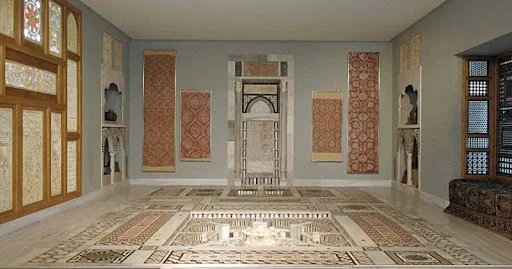Athens – the Benaki Museum
Benaki Museum is among the most extensive and innovative cultural organizations in Greece and Europe. The collections and the satellite museums cover historical periods from Antiquity and Byzance to the XX century and large geographical areas from Europe to China!
The Benaki Museum was founded in 1930 by Antonis Benakis (1873-1954), member of a pre-eminent Greek family in Alexandria, which made an invaluable contribution to the political, social and cultural life of Greece.
Benakis began forming his collections whilst still in Egypt and donated them to the Greek State in 1926, when he settled permanently in Athens. These collections are housed in his paternal home, one of the handsomest Neoclassical buildings in the capital near the National Garden and the Hellenic Parliament. Benakis and his three sisters, Alexandra, Penelope and Argine donated the mansion to the Greek Government and was converted into the first private museum in Greece.
The public responded immediately to Antonis Benakis’s initiative and as a result of its exceptional impact the Museum’s treasures quickly proliferated. Thanks to the constantly increasing number of benefactors and donors, the Museum continues to be endowed daily with valuable properties and independent ensembles of artworks which fill in the gaps in individual collections. Concurrently, the acquisition of new exhibits reinforces the research role of the Museum, namely the study of Hellenic as well as other cultures, important pieces from which are kept on its premises.
The rapid growth of the Museum’s holdings and activities necessitated the enlargement of its facilities, the hiving off of certain sections and their re-housing in new annexes; this entailed the overall review of the museological thinking behind the foundation.
The central building re-opened to the public in the summer of 2000 and in it is presented the historical and cultural development of Hellenism. Exhibits span the Neolithic Age to the twentieth century. Many of them are masterpieces of Greek art or are of seminal significance for Greek history: from Antiquity and the Roman era to the Byzantine Age, from the Fall of Constantinople (1453), the period of Frankish rule and the Ottoman Occupation, to the outbreak of the Greek War of Independence (1821), and from the time of the formation of the Modern Greek State until the Asia Minor Catastrophe (1922).
The temporary exhibition gallery hosts exhibitions and diverse other events each year, thus enriching the visitor’s image of Hellenic civilization. The Museum’s educational role is enhanced by the educational programmes for schoolchildren, the first to be organized in a Greek museum. The Museum shop offers high quality replicas of exhibits, while the cafeteria on the Museum terrace has become a very popular venue.
the permanent collections
Prehistoric, Ancient Greek and Roman Art
The collection of Prehistoric, Ancient Greek and Roman antiquities which is formed through the contributions of several Greek and foreign donors, as well as from the reserves of other museums, covers a vast chronological period stretching from the dawn of prehistory to the end of the Roman era.
Byzantine Art
The Byzantine collection links the ancient Greek world to that of modern Greece. The collection is exceptionally rich, although it is not representative of all the different artistic tendencies and currents which flourished during the thousand-year Byzantine Empire, and is divided into two groups.
The first group comprises bronze and silver household and ecclesiastical vessels, miniature sculptures and enamels, ceramics, manuscripts, etc., many of outstanding quality and workmanship.
The second group includes Byzantine and post-Byzantine icons, through which the evolution and development of iconography from the Byzantine period and the Palaeologan renaissance can be traced in the workshops of Crete and the artistic production of Mount Athos, up to the early stages of the modern Greek painterly tradition.
Historical heirlooms
The collection of historical heirlooms recreates the history of modern Greece from the end of the 18th century onwards. Many of the objects in the collection are family heirlooms donated by the descendants and relatives of individuals who are intimately connected with the history of modern Greece.
Many of the objects in the collection are family heirlooms donated by the descendants and relatives of individuals who are intimately connected with the history of modern Greece. A number of the more important items are connected with the Philhellenic movement and the struggle for Greek independence, as well as with Ioannis Kapodistrias’ attempts to create a modern Greek state (1828-1831). Others date to the reigns of King Otho (1833-1862) and King George I (1863-1913).
Post-Byzantine and Neo-Hellenic art
The collections of ecclesiastical and secular art cover the historical period from the 15th to the 19th century and provide evidence of the high level of culture in the Greek world during the Frankish and Ottoman occupations.
The collection of Post-Byzantine Ecclesiastical art consists of a selection of sacred and service vessels, liturgical vestments, jewellery and accessories, and church furnishings in carved wood. It covers the chronological period from the 16th century, when the Orthodox Church began recovering from the Ottoman conquest, to the early 20th century. The collections of Neo-Hellenic Secular art covers the chronological period from the fall of the Byzantine Empire in 1453 to the end of the 19th century, are thought to be unique in terms of their outstanding quality, number and variety.
Collection of Paintings, Drawings and Prints
Whilst the nucleus of this collection is made up of works from Antonis Benakis’ personal collection, the bulk of it is derived from the donation made by Damianos Kyriazis in 1953, as well as from subsequent gifts and bequests made by many other friends of the Museum. It includes a total of almost 6000 paintings and drawings by mainly European artists of the 17th to 19th centuries, as well as works by Greek artists of the 19th and 20th centuries.
The Library
The Library was established in 1931, the year in which the Museum was donated and inaugurated. It has to date gathered more than 100,000 titles of books and periodicals, the content of which is related to the material in the Museum collections and covers the following topics: Greek history and art, folklore, intellectual life and religion, particularly during the period of Turkish rule and modern times. It also has noteworthy collections of books about Islamic art and the art of the Far East.
a short video about the Benaki Museum
A film directed by Athina Tsaggari, narrated by Willem Dafoe and produced by Faliro House productions, is dedicated to the Benaki Museum and its founder. Music by Marilena Orfanou.
the Satellite museums
Visionary museum director Angelos Delivorrias insisted that donated items must be displayed in order to encourage public participation and strengthen ties with the community. Under his leadership the museum added more than 60,000 objects, books and documents and the museum was further endowed by various donors and today the Benaki Museum is a cluster of satellite museums that focus on specific collections.
Museum of Islamic Art
Housed in a Neoclassical building complex in the Kerameikos neighborhood, the museum’s collection is one of the few in the Western world covering Islamic art from the 7th through the 19th centuries, it has a rich collection of Ottoman art from the Empire’s peak in the 16th century.
read our post about the Museum of Islamic Art
Benaki Cultural Centre – Pireos Street
Athens – Benaki Museum Pireos St. Annexe
The Cultural Centre at 138 Pireos Street is housed in an industrial building of the 1960s, which has been transformed into a modern museum space designed to accommodate multiple events. The building includes a central atrium, also suitable for holding events, and a 400-seat amphitheatre.
Nikos Hadjikyriakos-Ghika Art Gallery
Nikos Hadjikyriakos-Ghika Art Gallery
The Nikos Hadjikyriakos-Ghika Gallery was gifted to the Benaki Museum by the artist and functioned as an annexe to the museum from 1991-2000, whereupon it closed temporarily for maintenance and building refurbishment. Work commenced in 2005 under architect Pavlos Kalligas and in May 2012 the Gallery re-opened its doors to the public.
Museum of Toys and Childhood in the Koulouras Mansion
Koulouras Mansion
The Kouloura mansion, located at Poseidonos Avenue in Palaio Phaliro and dating to the late 19th century, is designed in a characteristically neo-Gothic style with symmetrical towers and ramparts. One of the few such houses in the suburbs of Athens to have survived, was left to the Benaki Museum by Athanasios and Vera Kouloura. The building is now home to the extensive collection of historic toys and games that was donated by Maria Argyriadi in 1992 and which tallies almost 20,000 items from all over the world, including Greece and Europe, Japan and China, and spanning from antiquity and Byzantine periods to the 17–20th centuries.
Photographic Archives
The Benaki Museum’s Photographic Archives Department was established in 1973 to collect, preserve and document photographs of Early Christian, Byzantine and post-Byzantine art and architecture. Since then the Department’s original scope has gradually been extended to cover images of Greece and its culture, as well as its history and contemporary society.
From 1999 to 2015 (September), the Photographic Archives Department had been housed in premises, donated by Mary Carolou and Penelope Vlangali, at Plateia Philikes Hetaireias 15 in Kolonaki. Since 2016 the Photographic Archive is located in new premises with higher standard storage conditions at the Pireos Annexe.
Historical Archives
The Historical Archives housed in the house of Penelope Delta at Kifissia. They constitute one of the best organized and richest archival collections in Greece.
It became an independent department of the Museum in 1955. Most of the archival material comes from Antonis Benakis’ personal collection, as well as from subsequent donations by private benefactors.
Focusing on the history of the Greek nation, the museum collects documents, records and other historical artifacts, mostly relating to the political, economic, and social life of the last three centuries.
Archives of Neohellenic Architecture
The Modern Greek Architecture Archives (M.G.A.A.) of the Benaki Museum were founded in April 1995. Their objective is to collect all the diverse material (drawings, notes, publications, photographs, models etc.) related to the architecture and urban design of the neohellenic state, from its establishment in 1828 until today.
All this material is recorded and classified in order to make it accessible to researchers. They are housed in Benaki Cultural Centre – Pireos Street.
Yiannis Pappas Studio
Yannis Pappas Studio
The Yiannis Pappas Studio in the Zographou district it is in the same building that housed the family of this important artist and was also a workspace for the artist who loved both sculpture and painting. His son donated the home as he wanted the artist’s work to remain together in their natural physical space.
find out more about the Benaki Museum
Benaki Museum
1, Koumbari str & Vas. Sofias av., 106 74, Athens, Greece
Telephone: +30 210 3671000
Email: info@benaki.gr
Website: www.benaki.gr
OPENING HOURS
Wednesday and Friday: 10:00 – 18:00
Thursday and Saturday: 10:00 – 00:00
Sunday: 10:00 – 16:00
Monday and Tuesday: closed
✔ How to organize your holidays in Athens
Ferry to the islands: Book your ferry to to Santorini, Mykonos and other islands.
Hotels: Discover our selection with the best hotels and accommodation in Athens.
Tours and Activities: Explore the city with some amazing tours and activities.
Car rentals: Discover the the surroundings on your own by booking your car.























